This stunning persimmon pie would be a great alternative to the traditional pumpkin pie for the holidays. It’s smooth and creamy, lightly spiced with flavor notes of honey, pumpkin, and apricot. Serve with a dollop of freshly whipped cream for the perfect bite!
If pumpkin pie is the official pie of Thanksgiving, I’m declaring persimmon pie the official pie of Christmas (because as much as I love cookies, Christmas is sadly lacking in pies.) Pumpkin is so last month… this persimmon pie is it.
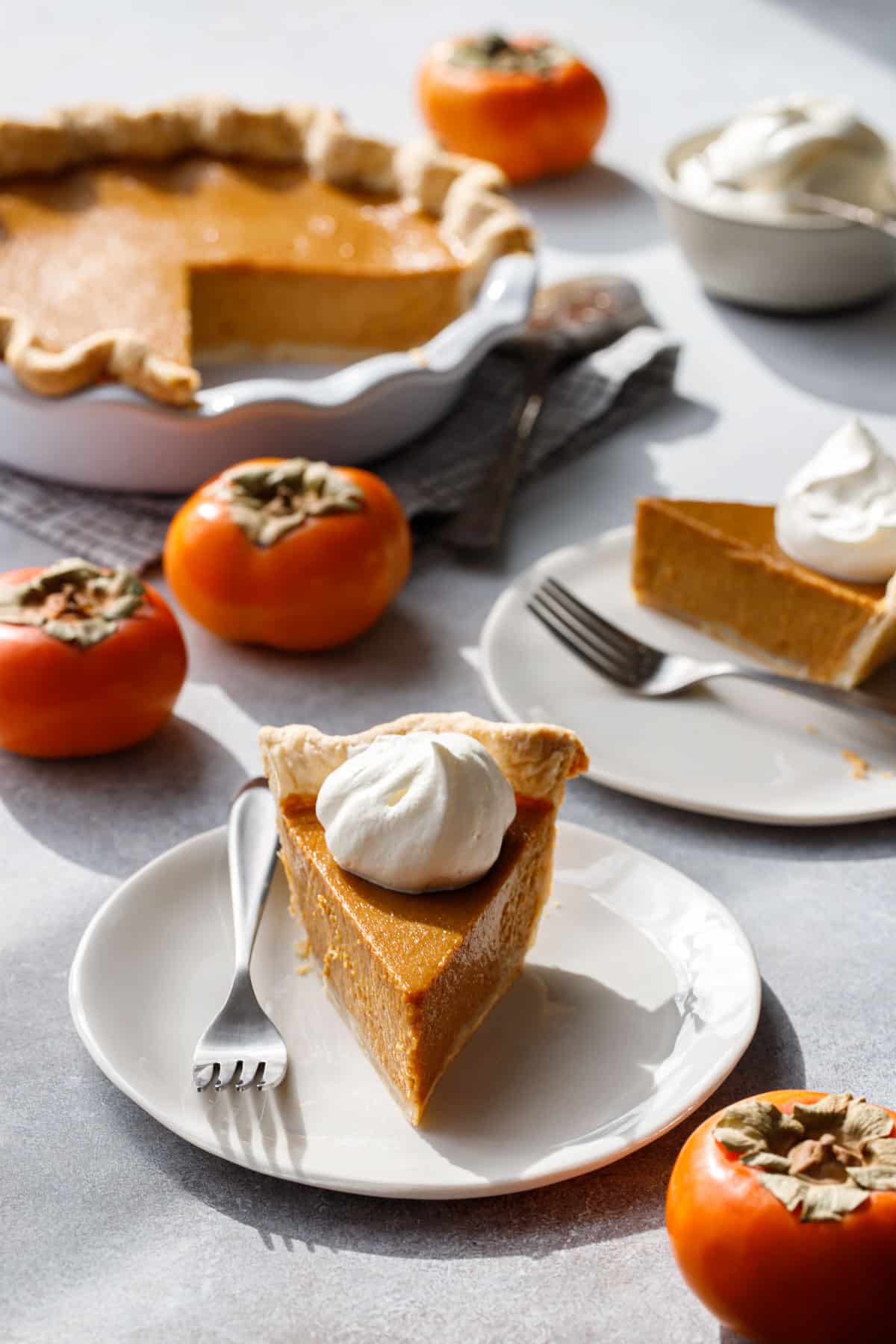
What looks like a pumpkin pie, tastes kind of like a pumpkin pie, but definitely isn’t a pumpkin pie?
Persimmon pie! Yes, I said persimmon! The fruit!
If you’ve never had a persimmon before, it’s one of my favorite fall/winter fruits. I’d describe their flavor as sweet and slightly tangy, somewhere between a peach or apricot and a pumpkin, with subtle notes of honey and even caramel that pairs beautifully with fall spices.
The pie itself is laced with seasonal spices, which does fool the brain a bit: upon first bite you may think you’re eating a pumpkin pie (and if I hadn’t told you it wasn’t pumpkin you may never know). Except, it’s not quite pumpkin like you’re used to. Maybe a little bit fruitier, perhaps? Like someone snuck a peach into the can of pumpkin puree (which sounds weird but also kind of wonderful?)
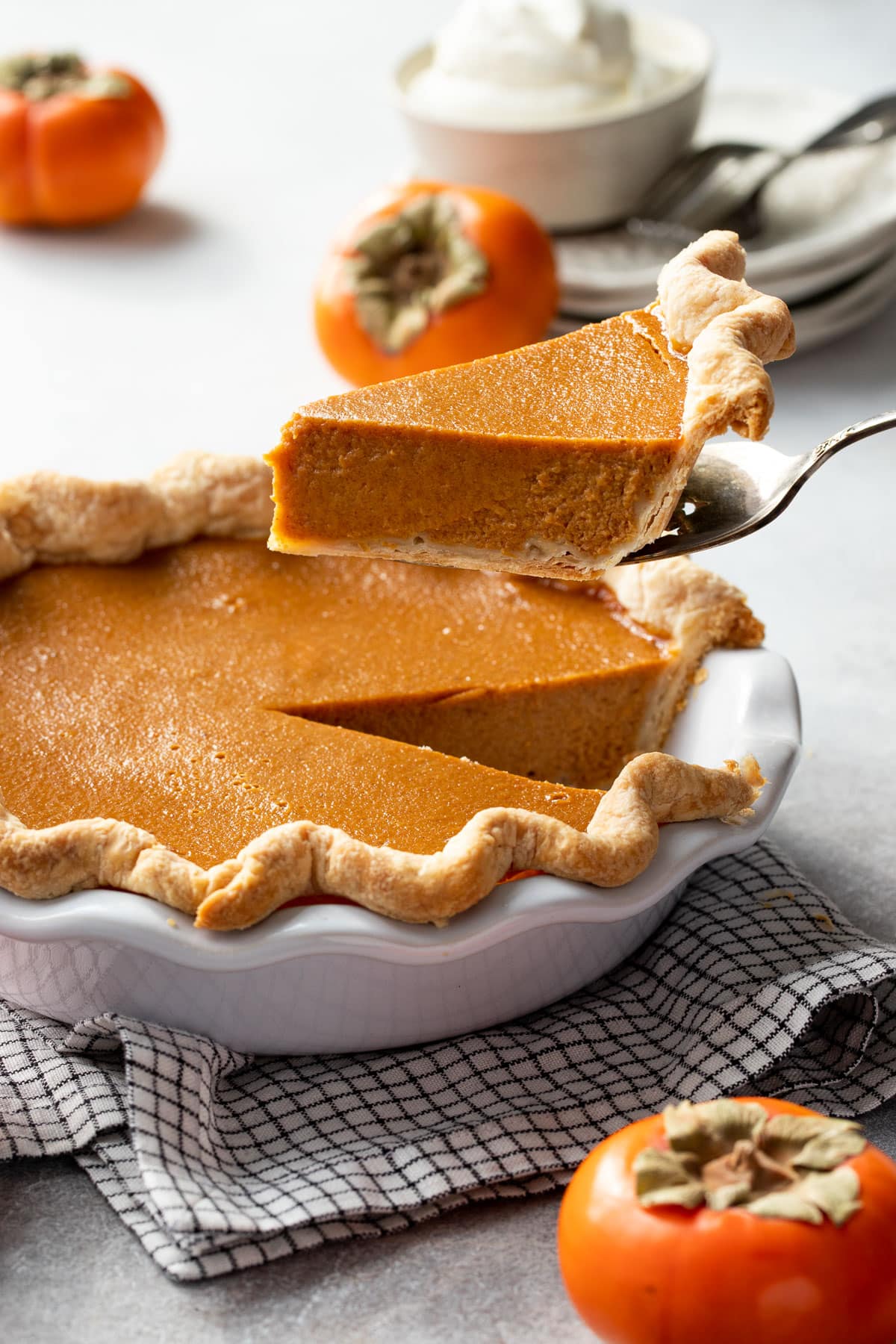
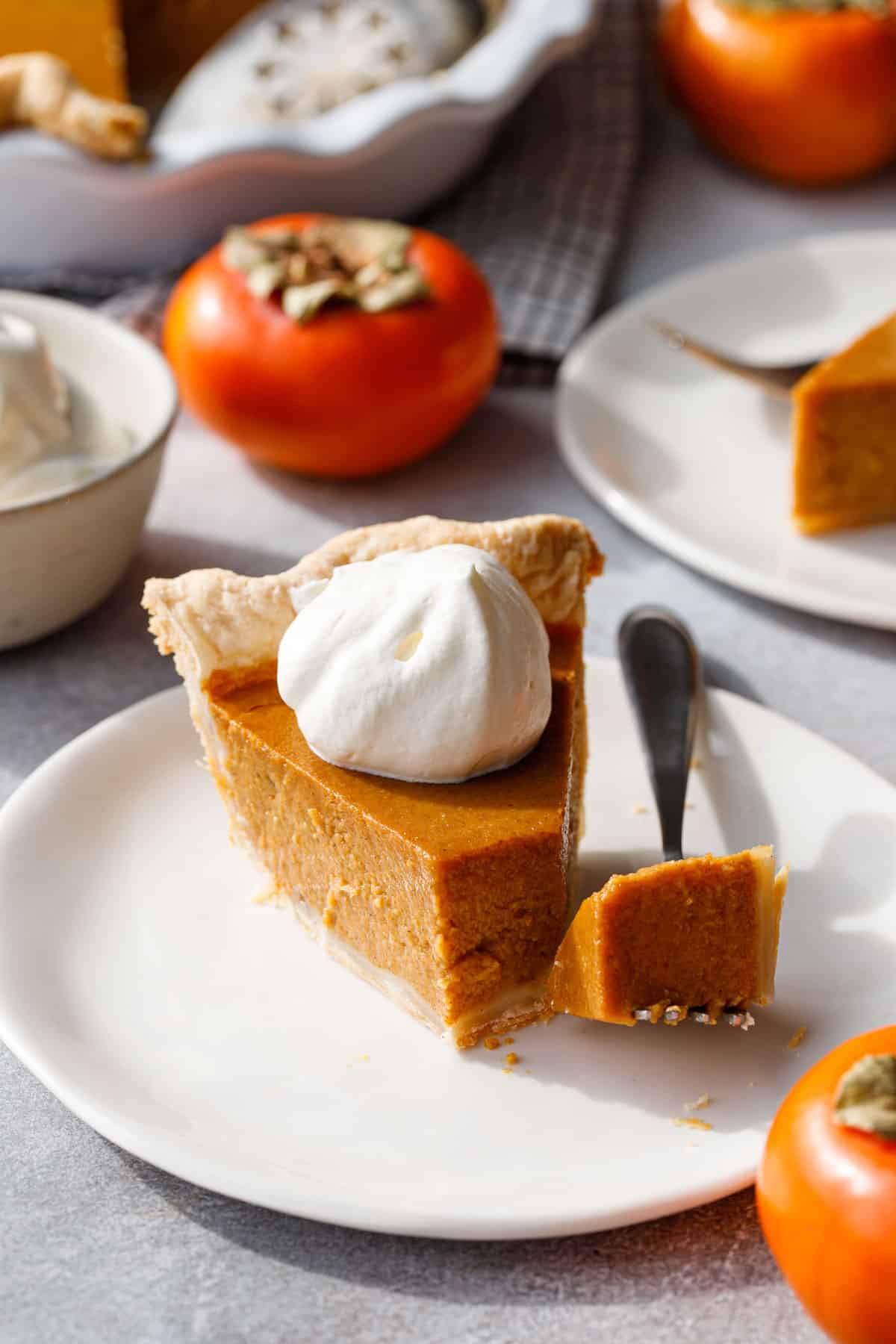
I became rather obsessed with making a persimmon pie after Twitter-friend Sara mentioned it. Having never heard of such a thing, I immediately went-a-googling to see what I could find. There’s really a dearth of persimmon pie recipes on the internet, but I managed to find two, one from Southern Living and one from MasterClass that I merged, tweaked, scaled and adapted to arrive at this final recipe.
One of the major issues with persimmon over pumpkin is the higher moisture content of the persimmon, which can lead to a slightly watery texture.
To remedy this, I reduced the persimmon puree by 25% before adding it to the custard base. Cooking out a bit of the water made a huge difference in the final texture of the pie, as well as using evaporated milk instead of regular milk or cream.
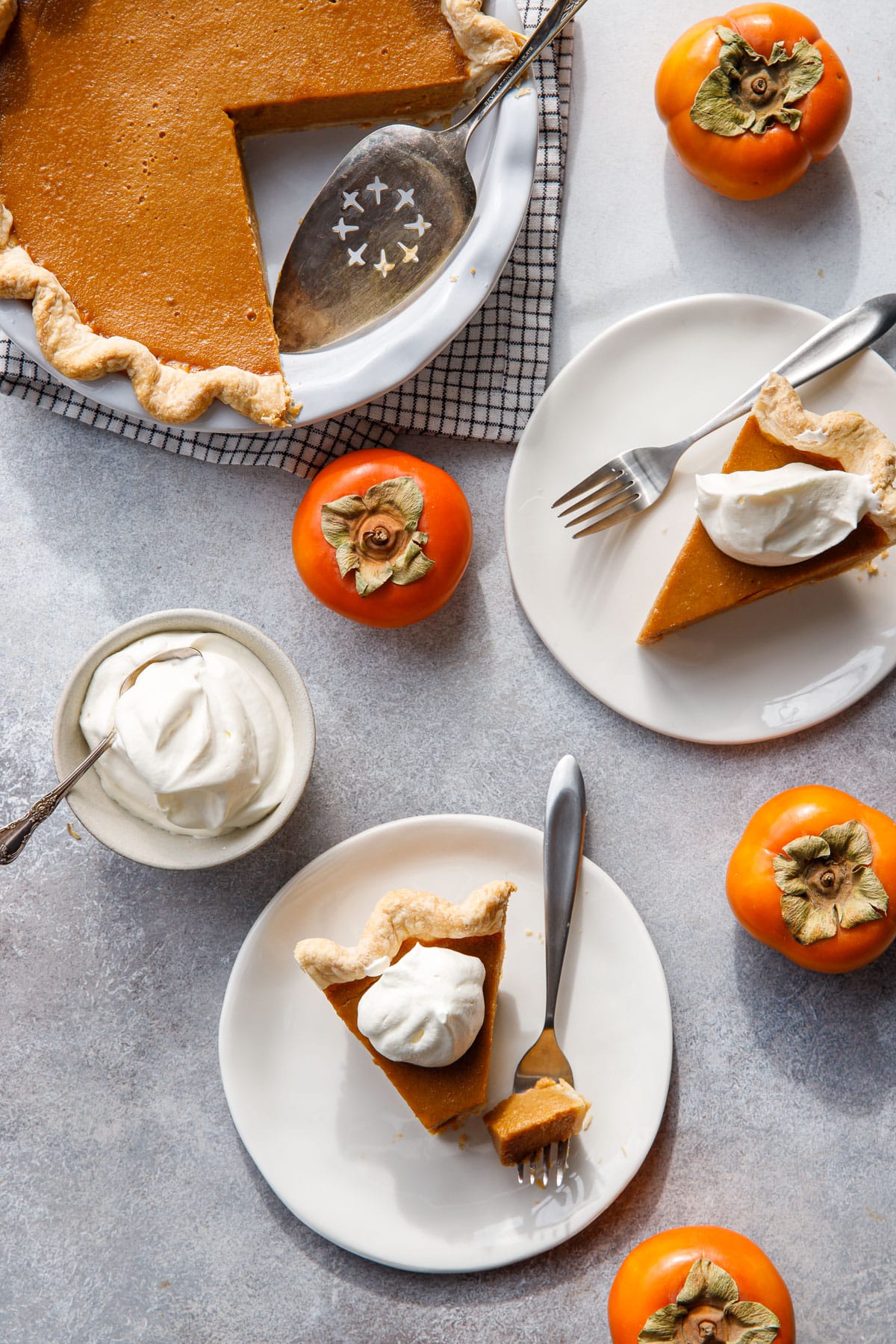
Types of Persimmons
There are two main kinds of persimmons that you’ll find in the US: Fuyu and Hachiya, as well as wild, native persimmons in some parts of the US.
For this recipe I recommend using Fuyu persimmons; astringent varieties like Hachiya sometimes have unexpected, undesirable results when cooked (if/when I figure out the cause/solution of this I’ll certainly update the recipe accordingly!)
Fuyu persimmons look like squat, orange tomatoes. Fuyu persimmons will be firm and almost apple-like in texture when they are undripe, and will soften into a sweeter texture as they ripen. I actually love using this kind of persimmon when they are still crisp, in recipes like these persimmon green beans and this winter persimmon salad. For this recipe you want them to be pretty soft (think ripe tomato or peach), as the flavor will be sweeter and fruitier, not to mention easier to puree.
Hachiya persimmons are the most common variety grown in Japan. Unlike Fuyus (which can be eaten unripe), these oblong, acorn-shaped fruits must be fully ripe before they can be eaten, otherwise they are unpleasantly astringent. When fully ripe, they will feel almost like a full water balloon… which, I know, sounds kind of gross (if you had a tomato that felt like that it would be entirely rotten), but trust me that that’s the way they are supposed to be.
American persimmons are native to the Eastern/Southeastern US (which includes Tennessee, apparently, although I’ve never actually seen them growing or available at farmers markets here). Wild American persimmons are generally smaller in size and contain large, flat seeds. They will also work in this recipe, though you’ll (obviously) need quite a few more of them to fill an entire pie.
To speed up ripening, place your persimmons in a paper bag with an apple or banana… though this will only do so much. If you plan to make this pie for Thanksgiving or another holiday, I recommend buying your persimmons at least a few weeks ahead of time. If they ripen early or you want to plan ahead, persimmons can also be frozen (whole or after they’ve been puréed).
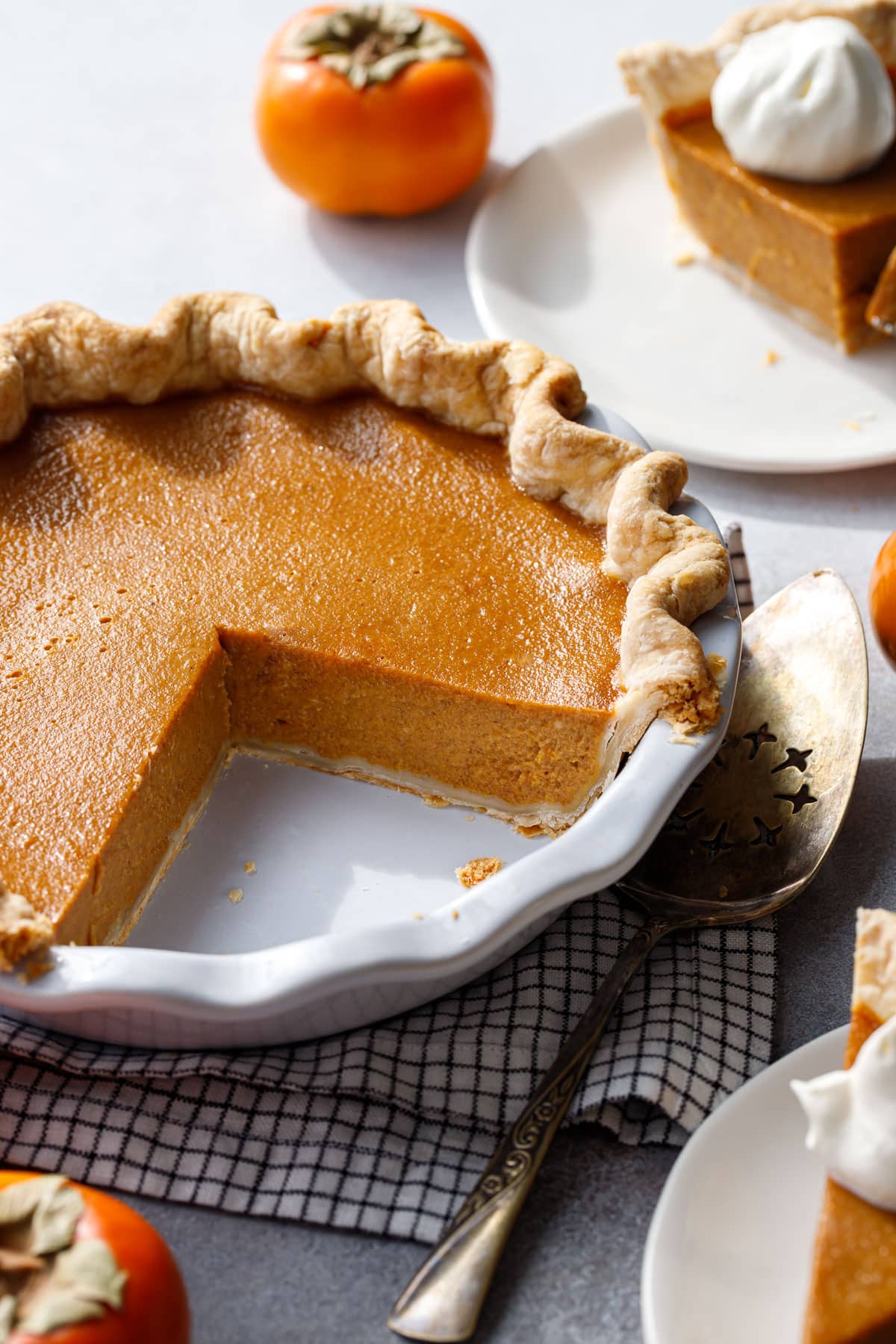
Preparing Persimmon Purée
To prepare your persimmons for this pie, you’ll first need to remove the skins (and seeds, if there are any) and purée.
For fuyu persimmons, if they are still firm-ish you can peel them with a vegetable peeler. When they’re soft it may be easier to cut out the core with a paring knife, then ‘scoop’ out the flesh with a spoon.
For hachiya persimmons, you’ll definitely need to scoop these ones, as the inside fruit will be almost custardy in texture. You can also freeze ripe persimmons whole, which will make it easier to remove the skins. (If I have a couple of hachiya persimmons waiting to ripen, I’ll freeze them as they ripen since they probably won’t all ripen at the same rate.)
You will need 2 cups of fresh persimmon puree for this recipe, which is about 6 hachiya or 8 fuyus worth.
Once you have the 2 cups of puree, you will then reduce this to 1 1/2 cups on the stovetop to remove some of the excess moisture (since persimmon fruit contains more water than pumpkin, reducing it like this will prevent the final pie from having a watery texture).
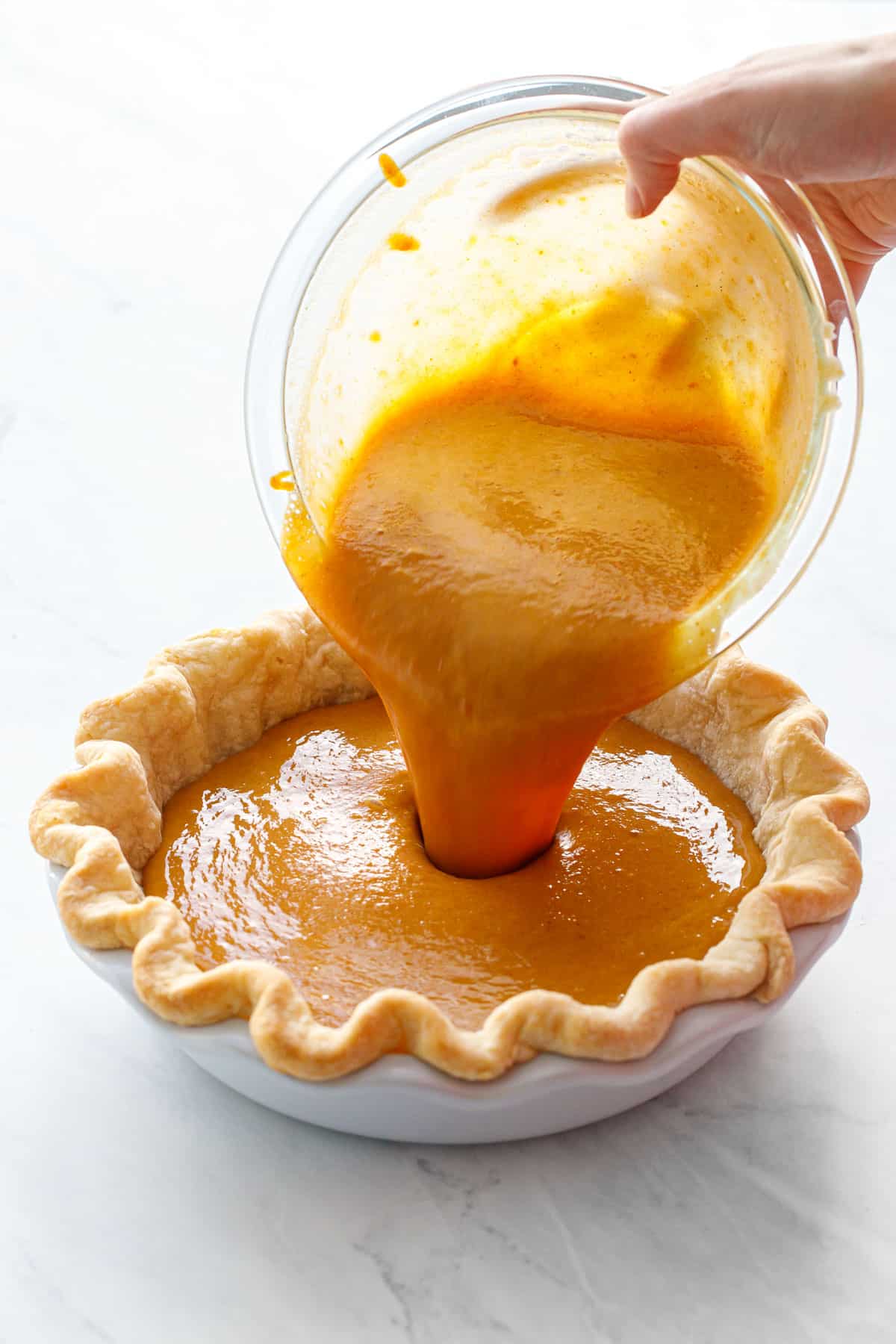
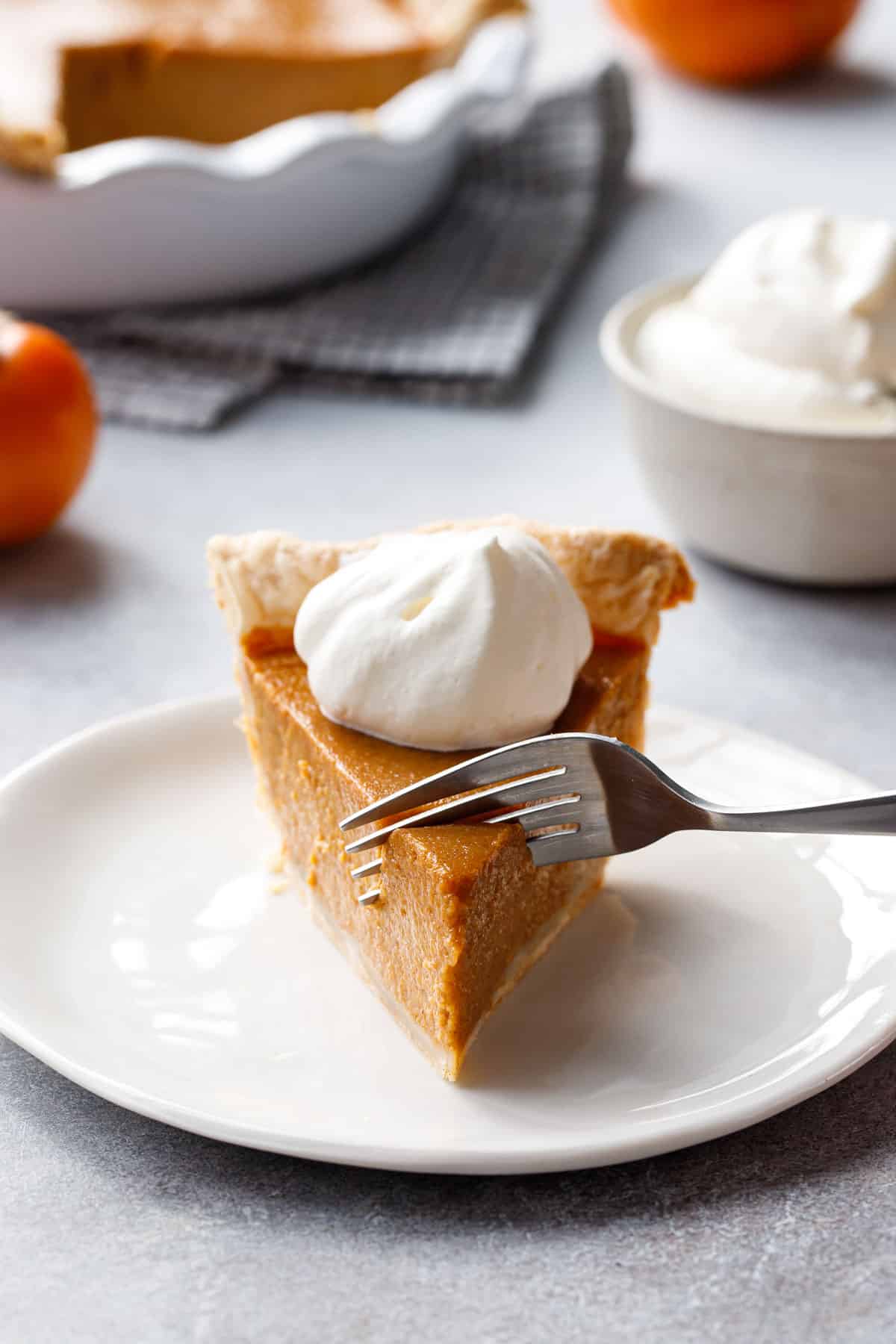
The pie crust recipe below was adapted from Laura’s stand mixer pie crust, scaled since this pie just needs a single crust. I find this crust recipe to be a perfect balance of simplicity, workability, and flakiness. But you can certainly swap in a pre-made pie crust or your favorite pie crust recipe instead.
Par-baking Pie Crust
To prevent soggy bottomed pie crusts, par-baking, or pre-baking, is essential.
I recommend freezing your shaped pie crust for 15 to 30 minutes to firm it up, then lining it with a crumpled piece of parchment paper filled with weights. I personally hate pie weights, and prefer to use granulated sugar (a trick I learned from Bravetart), you can also use rice or beans.
Partially bake the pie crust with the parchment and weights (the weight will prevent the crust from shrinking or slumping), then remove the parchment and let it bake a few more minutes to dry out.
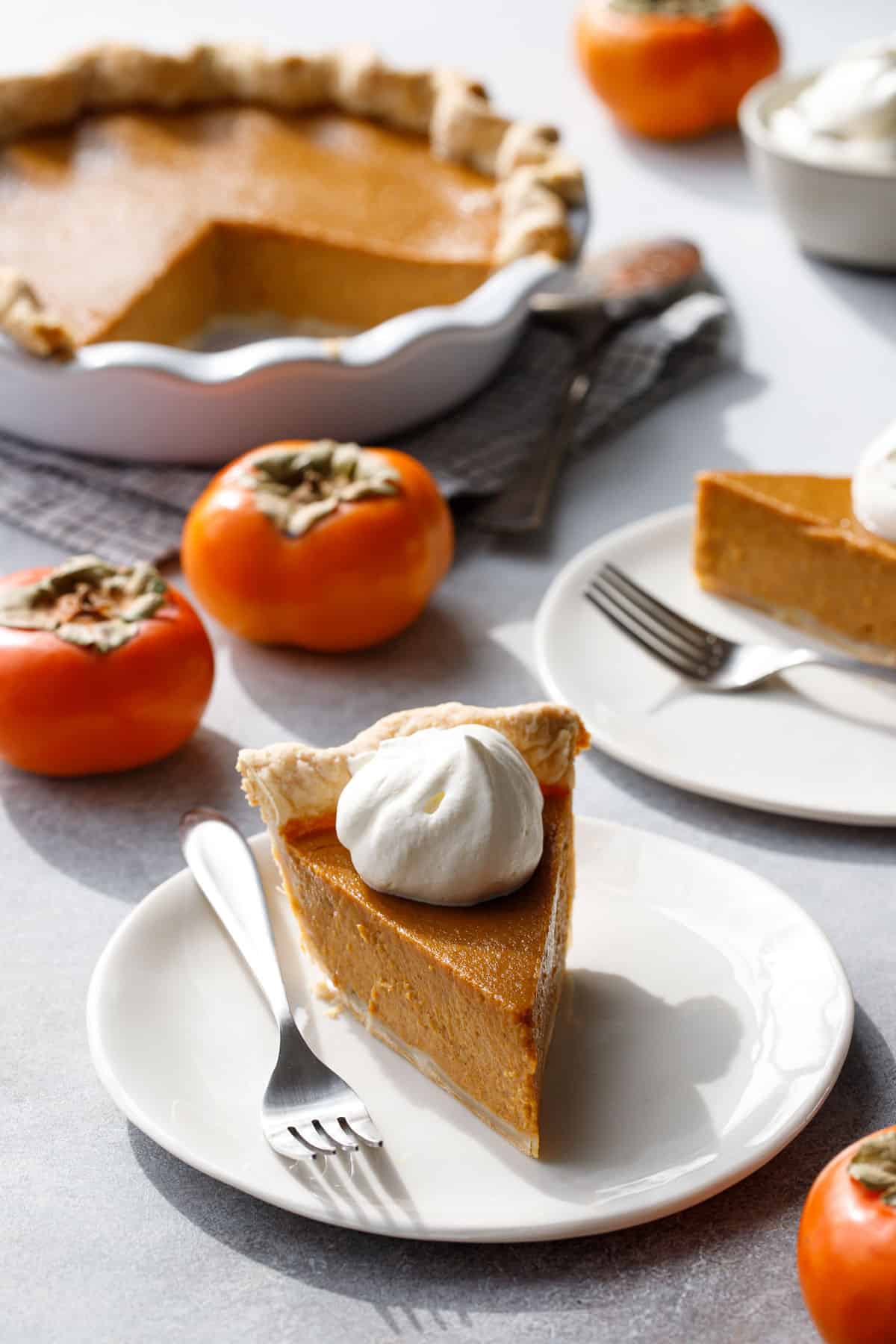
If you are looking for a perfect Christmas pie recipe, or a change from boring old pumpkin for Thanksgiving, this persimmon pie is just the ticket.
Serve with a generous dollop of freshly whipped cream or a scoop of vanilla bean ice cream. I’ve also seen some recipes served with a spiced pecan streusel on top, which would add a nice textural contrast to the creamy custard of the pie.
You can make this pie a day or so ahead of time, however much like pumpkin the longer it sits the more you risk a soggy bottom.
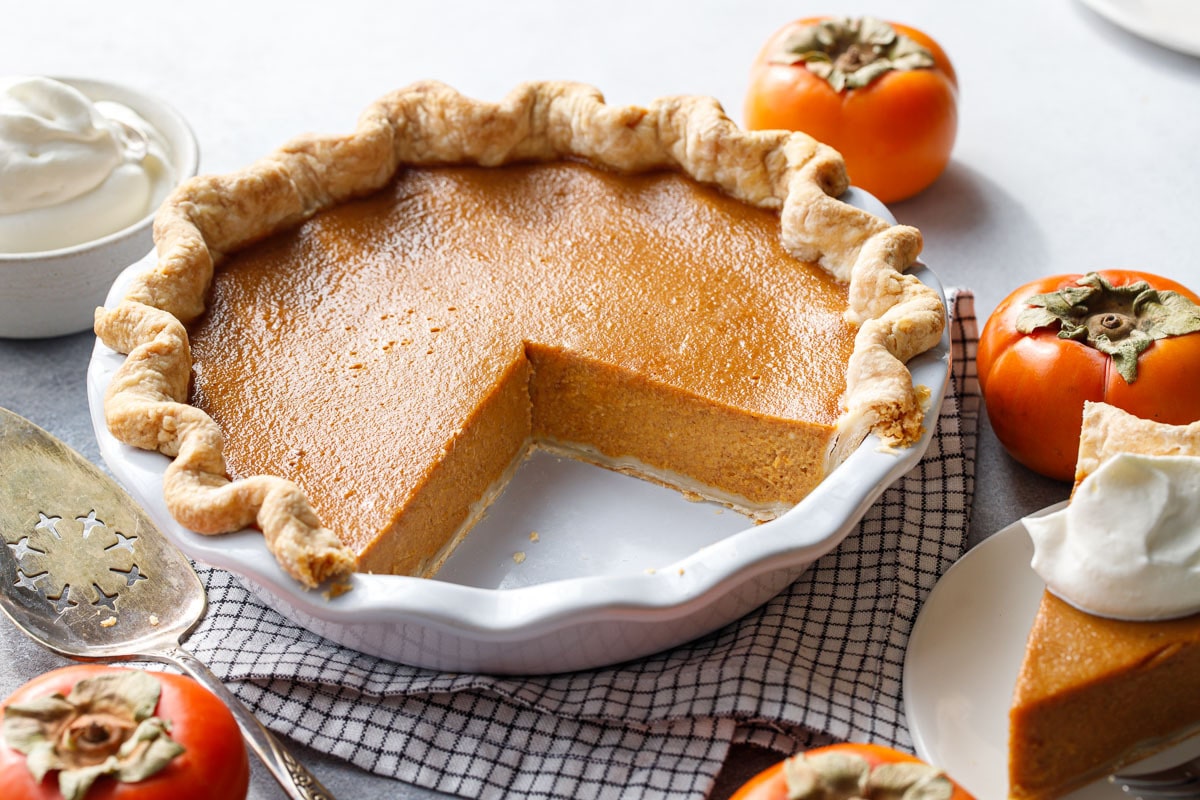
Persimmon Pie
Ingredients
For Crust:
- 1½ cups / 187 g all-purpose flour
- ¼ teaspoon fine sea salt
- ⅛ teaspoon baking powder
- ½ cup / 113 g (1 stick) very cold unsalted butter, cut into cubes
- 1 teaspoon apple cider vinegar
- 3 to 5 tablespoons ice water, as needed
For Pie Filling:
- 8 large ripe Fuyu* persimmons, enough to make 2 cups of puree
- ¾ cup / 192 g evaporated milk
- ½ cup / 105 g packed light brown sugar
- 1 tablespoon all-purpose flour
- 1½ teaspoons ground cinnamon
- ½ teaspoon ground ginger
- ½ teaspoon fine sea salt
- ⅛ teaspoon ground allspice
- 2 large eggs
- 1 large egg yolk
- 1 teaspoon vanilla extract
Instructions
To prepare crust:
- Place the flour, salt, and baking powder in the bowl of a stand mixer fitted with the paddle attachment. The colder the better for all the ingredients and tools.
- With the mixer on low speed, slowly add the cold butter a few cubes at a time, until the butter breaks up into pea-sized crumbs (any larger chunks you can break up with your fingers).
- Add the apple cider vinegar and one tablespoon of ice water at a time, mixing on low speed until it just barely comes together into a crumbly dough (you should be able to pinch a piece of dough and have it hold together). Knead the dough once or twice to form a ball, then form into a disc. Wrap tightly in plastic wrap and refrigerate for at least 1 hour or overnight.
- Preheat your oven to 400 degrees F. Let the crust come to room temperature for 20 to 30 minutes (it should be still cool but pliable).
- Roll out crust into a round large enough to fit into your pie pan with a 1-inch overhang. Gently transfer rolled out crust to pie pan, easing it into the pan so as not to stretch the dough. Trim any uneven edges so there is a nice even overhang around the entire pie.
- Fold the overhang under itself, then crimp as desired. Refrigerate for at least 30 minutes or freeze for 15.
- Line pie with a piece of crumpled parchment paper or foil, lightly draping over the crimped edges. Fill with granulated sugar to weight it down (pie weights work too, also dried rice or beans).
- Bake crust for 15 minutes, then remove from oven and carefully lift out parchment with weights. Pop it back in the oven for another 5 to 10 minutes until the bottom dries out a bit and the edges just barely start to brown. Place on a wire rack and let cool while you prepare the filling.
For the Filling:
- Reduce oven temperature to 350 degrees F.
- Peel and core persimmons (or, if very ripe, scoop out the jelly-like flesh with a spoon). Discard seeds, if any, then place in a blender and pulse until smooth.
- Transfer to a saucepan set over medium heat, bring to a gentle simmer and cook, stirring consistently (be careful as it will bubble and sputter), until puree has reduced to 1½ cups, about 15 minutes. This step can be done ahead of time, refrigerate reduced puree in an airtight container for up to 5 days, or freeze for up to a month.
- Add evaporated milk, brown sugar, flour, salt and spices. Return to heat and warm until it just starts to bubble.
- Whisk eggs and egg yolk in a bowl until smooth and uniform. Ladle in hot persimmon mixture, 1/4 cup or so at a time, whisking constantly to incorporate. Continue to ladle in hot persimmon mixture until about half has been incorporated and egg mixture is hot to the touch. Return entire mixture to saucepan and whisk until smooth. Whisk in vanilla, then pour into prepared crust.
- Bake for 50 to 60 minutes or until edges are set and center is just slightly jiggly (if you want to be precise about it, the interior temperature will read 180-190 degrees F when the pie is done.
- Remove from heat and let cool completely on a wire rack, then lightly cover and refrigerate until ready to serve, up to a day ahead of time (technically it can be made further ahead of time but the crust may get a little soft after a day or two).
Notes
- *For this recipe I recommend using Fuyu persimmons. While fully-ripe Hachiyas should work in theory, they can sometimes have unexpected (and undesirable) results when cooked. I'm still trying to figure out a workaround for this variety, and will certainly update the recipe here when/if I do so.
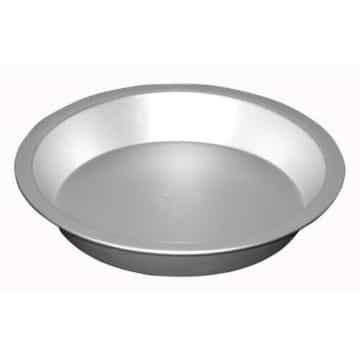
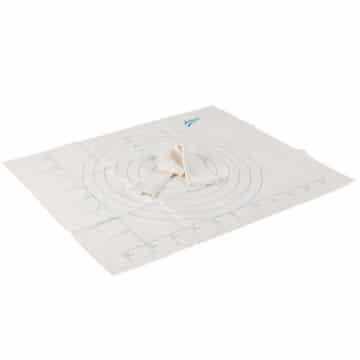
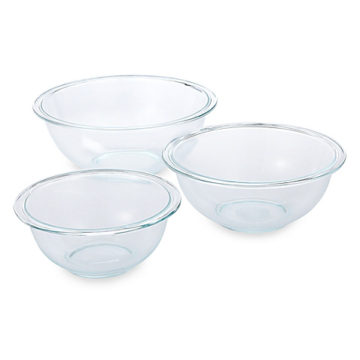

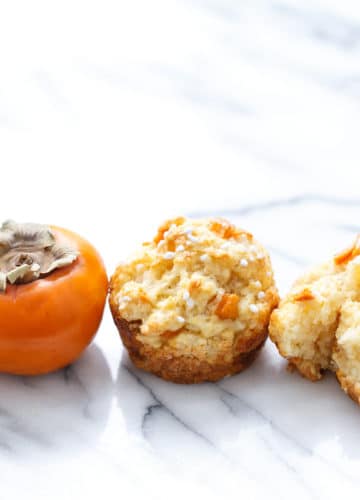
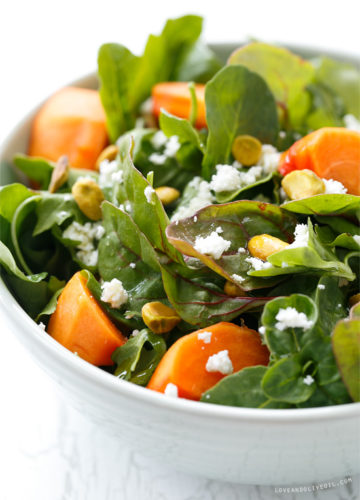
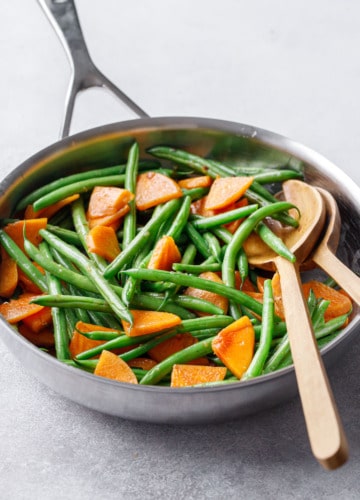
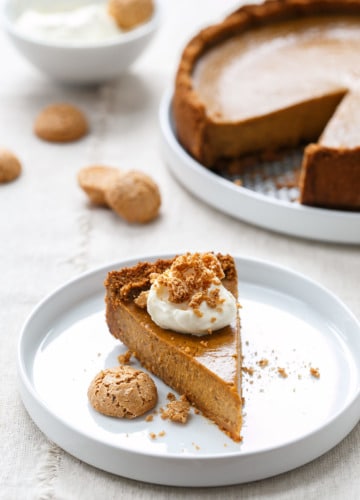
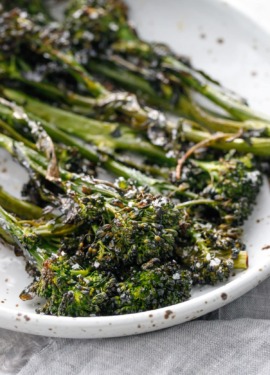
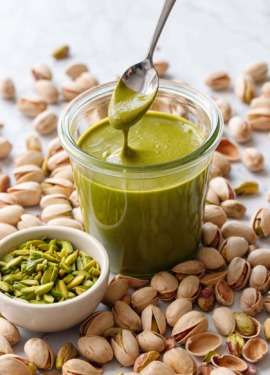
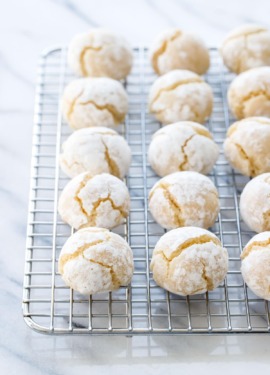
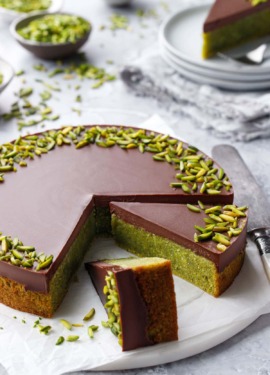
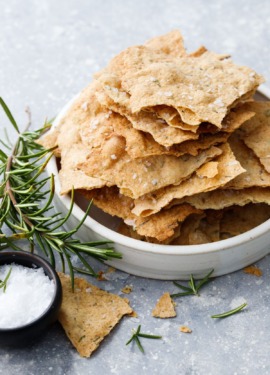
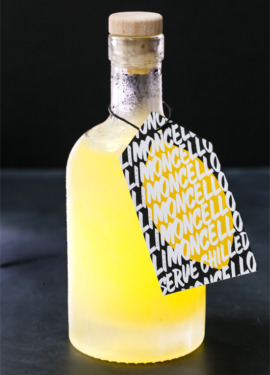
At what point do you add the vanilla? I made this according to the directions but didn’t see where the vanilla was added so left it out…
Vanilla gets whisked in at the end before the filling is poured into the crust.
Persimmon grower here in Central California. We grow both Hachiya & Fuyu varities. Every recipe with Hachiya persimmons I’ve used always calls for baking soda. It should be mixed directly with the pulp. Adding baking soda, an alkali, directly to the persimmon pulp is an attempt to reduce astringency and to ensure that the tannins cause no further reactions as the batter is mixed. I will make this recipe with Hachiya pulp and that adaptation of baking soda and let you know how it turns out.
i made this and it was so easy and turned out so well!! Thank you so much! Made it for a friend’s birthday who loves persimmons and she loved it.
This is such a cool recipe!! What would you think if I added like say a tablespoon of peach jello or peach flavoring?
I really don’t think that’s necessary. The subtle fruitiness of the persimmons is very pleasant all on its own!
Thank you so much!! It’s going in the oven shortly ❤️ Very excited!!
I am halfway through making this recipe and wanted to confirm; you bake the pie once it’s filled at the same temperature as the crust? 400 degrees?
350 actually! I’ve updated the recipe to clarify.
good tip about Fuyu persimmons versus Hachiya and even some of the wild varieties and how they bake, since I’ve never baked with persimmons before, a definitely different pie for me, thank you!
A shortcut for unripe Hachiyas is to freeze them whole; even if not fully ripe, once they thaw the astringency will be gone. We have a huge Hachiya tree that gives far more fruit than we could ever get through in time, so I freeze them once they have colored, even if still quite firm, and pull them out to thaw and use as needed throughout the year. Hope this helps!
My persimmon reduction separated like curdled milk. It quickly transformed into clear, sweet liquid and inedible, tannin-heavy solids. I used super ripe hachiyas that came from my tree, too (so ripe they were like water balloons). I think it must be a reaction from the heat. Now I’m depressed about wasting my precious persimmons! My one comfort is that I only used 3 and not 6 of them like the recipe suggested. Hopefully this helps warn others!
This is very strange. I used 6 fuyu and 1 hachiya for my pie and did not experience this. If you haven’t thrown it out yet, I wonder if a quick blitz in the blender would homogenize the puree again. Although that would only help with texture, not taste.
I have a few more hachiyas (slowly) ripening now, once they are ripe I’ll give it a try on my end and see if I can’t figure out why this happened to you. It’s possible that hachiyas behave differently from fuyus when cooked, although if cooking them was a problem you wouldn’t see so many recipes for persimmon breads, puddings, etc calling for this type of persimmon.
I’m also wondering if they weren’t fully ripe despite appearances. I’ve seen some recommendations to freeze the fruit first to help remove astringency, also soaking in warm water or even vinegar water for 24 hours.
So looking around a bit more I’ve encountered a few recipes for persimmon jam where there are comments noting a similar result as you, that sometimes even seemingly-ripe Hachiyas revert to their pre-ripe, astringent state after being cooked (there are also mentions of a curled appearance like yours).
I’m still going to play with the few hachiya persimmons I have on hand to see what happens, and if I can figure out a way around this (trying the water/vinegar soak perhaps, or adding a big of baking soda to the puree?) In the meantime I’m updating the recipe to recommend using Fuyu or other non-astringent varieties of persimmon.
You need to try the American persimmon.
The wild variety has twice the flavor as the ones you are using.
My Grand maw always made a pudding from them. It makes squares that are rich moist a some what sticky.
If I could find some I certainly would!
When I lived in PA my neighbor let us gather wild persimmons on her farm and we would freeze the pulp for persimmon pudding, a sort of dark rich thing that’s halfway between custard and cake. I only know where to find one wild tree where I live now and I try to leave the fruit for wild creatures to eat. Maybe it’s time to try grocery store persimmons.